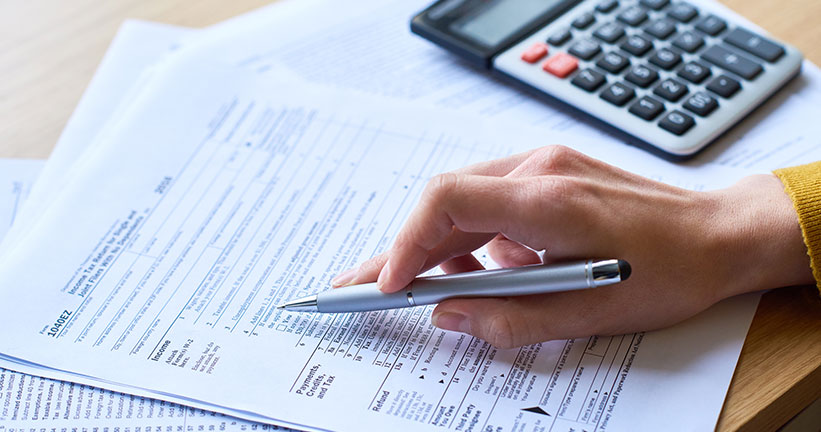
FDIC-Insured - Backed by the full faith and credit of the U.S. Government

FDIC-Insured - Backed by the full faith and credit of the U.S. Government
 VIEW ALL EDUCATION & INSIGHTS
VIEW ALL EDUCATION & INSIGHTS
January 18, 2018
Filing Your First Income Tax Return

Filing your income tax returns may sound frightening, but if you take a deep breath and do your research, you may find it is not as scary as it may seem. It is something that everyone has been doing since 1913 and is something you will be doing for the rest of your life. You may decide to use a professional to prepare your return or prepare it yourself with or without the help of income tax software like TurboTax or TaxCut. In any case, there are some things you should know to make the whole process easier.
The Basics
How do income taxes work? The income tax laws are quite complex, but they generally boil down to a few fundamentals:
- Income subject to tax includes wages, investment income (dividends, interest and capital gains), distributions from retirement plans, self employment income, income from partnerships and Sub-Chapter S corporations and a few other items.
- Then, that income is reduced by certain adjustments. Most people have few of these, other than deductible IRA contributions and certain tuition and educational expenses.
- You then get deductions for itemized expenses like state and local taxes paid, mortgage interest, charitable contributions and a few other less common items. If you do not have a lot of these itemized deductions, you are allowed to take a standard deduction. For returns filed in 2018, the standard deduction for single filers is $6,500 and $13,000 for married couples filing a joint return. You also get a reduction for personal exemptions you claim.
- The net of these three items is your taxable income.
Once you have your taxable income calculated, you then apply different tax rates based on the bracket of your income. There are different rates for single individuals and married couples filing joint returns. Think of this like a stair step – income in your lowest brackets is taxed at the lowest rates and as you climb the stairs, your taxable income gets taxed at higher rates.
Income Tax Rate Schedules for 2018
|
2018 Single Return Rate Schedule |
|
2018 Married Filing Jointly Rate Schedule |
||
|
Taxable income levels |
Tax rate |
|
Taxable income levels |
Tax rate |
|
0 to $9,525 |
10% |
0 to $19,050 |
10% |
|
|
$9,526 to $38,700 |
12% |
$19,051 to $77,400 |
12% |
|
|
$38,701 to $82,500 |
22% |
$77,401 to $165,000 |
22% |
|
|
$82,501 to $157,500 |
24% |
$165,001 to $315,000 |
24% |
|
|
$157,501 to $200,000 |
32% |
$315,001 to $400,000 |
32% |
|
|
$200,001 to $500,000 |
35% |
$400,001 to $600,000 |
35% |
|
|
Over $500,000 |
37% |
Over $600,000 |
37% |
|
Then you determine if you owe money with your return or if you have a refund coming. Your employer withholds income taxes from each paycheck. You simply compare what has already been withheld with your calculated tax liability. Generally, unless you have a lot of non-wage income or a complicated tax situation, you will have a small refund or owe a small amount. If your refund is large or if you owe quite a bit, you should consider changing how much you are having withheld.
Information you will need
For most people starting out and not using itemized deductions, the information you will need is simple – your employer will send you a Form W-2 for your wages and your financial institutions will send you Form 1099s with information on your dividends, interest and other investment income.
If you are itemizing your deductions because you have deductions larger than the standard deduction amounts, you will need information documenting those expenses. Your W-2 will have information on state and local income taxes withheld, you will get a statement from your mortgage lender with mortgage interest information and you will need cancelled checks or other receipts for other deductions.
When to file
Your income tax return is usually due on April 15th of the following year. However, your 2017 return is due on April 16, 2018 which is a Monday. You can file earlier if you wish. You should get your W-2 by the end of January and your 1099 forms shortly thereafter.
You can also file an application for extension of time to file your return, but most people do not do this unless they absolutely need to. In addition, getting an extension does not remove the requirement of paying any amount due beyond April 15th.
What IRS form(s) you will need
If you are not using itemized deductions, you can probably use IRS form 1040 EZ. Otherwise, you will probably need several forms – 1040, Schedules A & B and Schedule D. These forms are available online at www.irs.gov, and you can usually find them at public libraries and post offices.
You may also want to consider using income tax software to prepare your return. There are several programs available, including TurboTax, TaxCut and others. These programs make the process easier by stepping you through an interview and printing the forms. They also can enable you to file your return electronically. The IRS website also may have simple software available.
What to keep and for how long?
Most of the advice here is relatively simple. You should keep copies of your actual returns forever and you must keep the documents to support anything on your return for three years following the due date of the return.
Where it gets complicated is usually with investments and home ownership. You need to be able to document what you paid for a stock for three years past the due date of the return reflecting the sale of the stock. Most brokerage firms provide a year end statement that shows this information, so it is a good idea to keep year end statements. Record retention for home ownership involves keeping records of what you paid for your home and the cost of any improvements you make.
Everyone’s tax situation is different. This article presents only some of the basic information you may find helpful. If your situation is complicated or if you do not feel comfortable with any part of preparing your return, find and use the services of a qualified tax professional.








 Views
Views

 Views
Views

 Go Back
Go Back











